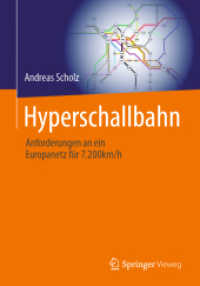- ホーム
- > 洋書
- > 英文書
- > Science / Mathematics
Full Description
This book aims to provide readers with hands-on knowledge about real-time operating systems and their possible application in the embedded systems domain to streamline, simplify, and make software development more efficient, without requiring any significant previous experience with them. A thorough presentation of operating system-based programming techniques is especially important because they enjoy an ever-increasing popularity in the embedded systems domain but are often misunderstood, because they still lack comprehensive support in the scientific and technical literature.
The book analyzes in detail three realistic case studies of increasing complexity, of which the first one requires only a commonly available PC or laptop, while the other two involve low-cost, open-source hardware platforms readily available to the majority of readers. They serve as starting points and running examples while introducing theoretical concepts, as well as real-time operating systems' operations and interfaces. A set of exercises and their solutions completes the book, to enable readers to self-assess their knowledge as they proceed. Moreover, the source code developed for the case studies is freely available for download and further experimentation.
Provides hands-on description of the most important real-time operating system concepts
Includes case studies of practical interest to experiment with while reading the book
Provides an in-depth, but accessible presentation of real-time scheduling theory
A balanced mix of operating system theory, exercises, and case studies in a single book
The use cases involve inexpensive hardware boards readily available on the market
Together, the topics covered by this book help embedded system designers understand benefits and shortcomings of real-time operating systems and then decide whether it may be worth adopting one of them for their next project instead of relying on more traditional, but less powerful, techniques. At the same time, students will acquire all the knowledge and skills they need to take part in real-world embedded software development without sacrificing a proper theoretical foundation. In this context, the case studies play the crucial role of underlining the strong relationship between operating system theory and application, along with the relevance of theoretical concept in day-to-day project design and implementation.
Contents
Part I - Concurrent Programming Concepts 1. Introduction 2. A Case Study: Vision Control 3. Real-Time Concurrent Programming Principles 4. Deadlock 5. Interprocess Communication Based on Shared Variables 6. Interprocess Communication Based on Message Passing 7. Interprocess Communication Primitives in POSIX/Linux 8. Interprocess Communication Primitives in FreeRTOS 9. Network Communication Part II - Real-Time Scheduling Analysis 10. Real-Time Scheduling Based on the Cyclic Executive 11. Real-Time, Task-Based Scheduling 12. Schedulability Analysis Based on Utilization 13. Schedulability Analysis Based on Response Time Analysis 14. Task Interactions and Blocking 15. Self-Suspension and Schedulability Analysis 16.General-Purpose IoT/Embedded Controller 17.Real-Time, High-Performance Data Acquisition (Redpitaya) 18. Control Theory and Digital Signal Processing Primer







